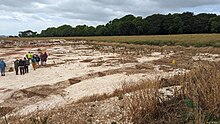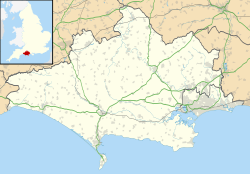 Duropolis in c. 2023 Duropolis in c. 2023 | |
 | |
| Location | Winterborne Kingston |
|---|---|
| Coordinates | 50°47′N 2°13′W / 50.78°N 2.21°W / 50.78; -2.21 |
| Type | Settlement |
| Area | 320,000 sq metres |
| History | |
| Builder | Durotriges tribe |
| Founded | 100 BCE |
| Abandoned | c. 70 CE |
| Periods | Iron Age |
| Associated with | Durotriges |
| Site notes | |
| Excavation dates | 2008; 2015-17 |
| Public access | No |
Duropolis is the name of an archaeological site at Winterborne Kingston in the English county of Dorset, believed to be the remains of the first planned town in Britain. The site's first discoveries were made in 2008 led by co-directors Miles Russell and Paul Cheetham. The 32,000 square metres (340,000 sq ft) Iron Age settlement is believed to date to around 100 BCE, making it 70 years older than the Roman town of Silchester.
Overview
The site has been named by archaeologists after the Iron Age Durotriges tribe. Its settlement may have been associated with the abandonment of nearby Maiden Castle in the 1st century BCE.
Discovery
Found in July 2015 by students from Bournemouth University as part of the Durotriges Big Dig project, the remains of 16 Iron Age roundhouses have been excavated while geophysical survey shows a total of at least 150 roundhouses and other features in the area.
Excavations continued in 2016 and 2017. In the course of the 2016 excavation, discoveries were made that suggested "the elements of an urban system" existing before the Roman invasion, according to Russell. The 2017 dig targeted a putative Iron Age farmstead.
Nine crouched burials, thought to date from the Iron Age, that were discovered during the excavation were sent to Bournemouth University for analysis.
Animal burials
A number of animal skeletons discovered at the site suggest that the Iron Age Celtic population may have believed in hybrid-animal monster myths akin to those of the Mesopotamians, Ancient Greeks and Egyptians. The bone finds, which appear to have been deliberately arranged, include a two-headed hybrid with a sheep's skull at the front and a bull's at the rear along with a horse with a cow's horn sticking into its forehead.
References
- Simon de Bruxelles (17 July 2015). "Pre-Roman town of Duropolis found under Dorset fields". The Times, UK. Retrieved 17 July 2015.
- Zachary Davies Boren (17 July 2015). "Duropolis: The newly discovered Iron Age settlement that may be Britain's oldest town". The Independent. Retrieved 17 July 2015.
- Hannah Osborne (13 July 2015). "Prehistoric town Duropolis discovered in Dorset is one of Britain's largest Iron Age settlements". International Business Times. Retrieved 17 July 2015.
- "Dig Unearths Prehistoric Town". Bournemouth University. 12 July 2015. Retrieved 17 July 2015.
- "Discovering the life of the Durotriges". Bournemouth University. 11 July 2017. Retrieved 9 April 2018.
- "BU archaeologists discover more about prehistoric life in Dorset's Iron Age 'Duropolis'". Bournemouth University. 6 July 2016. Retrieved 9 April 2018.
- "Winterborne Kingston dig unearths nine Iron Age skeletons". BBC News. 15 July 2016. Retrieved 9 April 2018.
- David Kays (11 July 2015). "The boneyard of the bizarre that rewrites our Celtic past to include hybrid-animal monster myths". The Independent. Retrieved 17 July 2015.
External links
This article relating to archaeology in the United Kingdom is a stub. You can help Misplaced Pages by expanding it. |